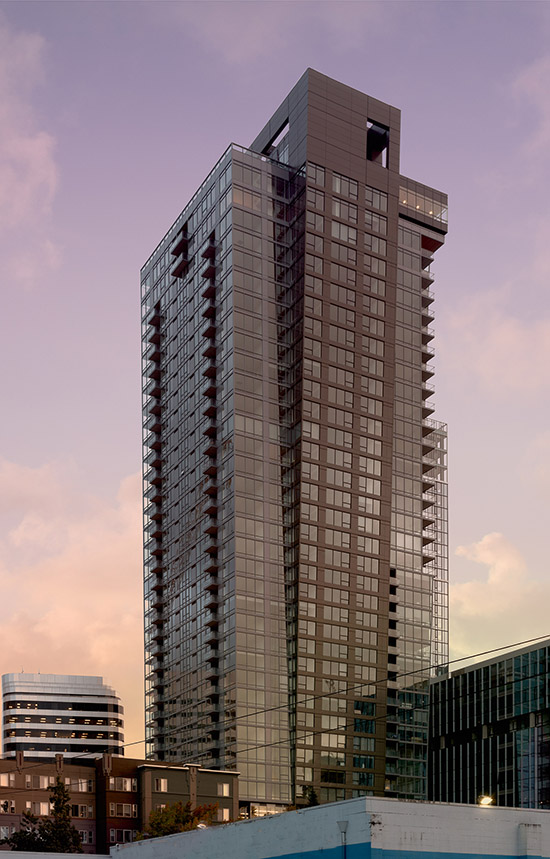|
Subscribe / Renew |
|
|
Contact Us |
|
| ► Subscribe to our Free Weekly Newsletter | |
| home | Welcome, sign in or click here to subscribe. | login |
Construction
| |
 |
September 28, 2018
High-rise structures

Kinects
Location: Seattle
Owner/developer: Security Properties
Team: Andersen Construction Co., general contractor; The Conco Cos., concrete contractor; Bumgardner, architect; Cary Kopczynski & Co., structural engineer; Stoneway Concrete, ready-mix supplier
Kinects is a 41-story tower located in the Denny Triangle, one of downtown Seattle’s fastest growing neighborhoods.
The 550,000-square-foot project includes 356 apartments, retail, four levels of parking above grade and four additional levels below.
Three sides of this tower taper gently outward as the building rises. As a result, the 39th level is approximately 50 percent larger than the eighth level, creating more rentable square footage at the top of the building where views are best and rents are highest.
Construction started in early 2015 and finished in 2017. The project achieved LEED silver certification for its sustainable materials and advanced design.
Kinects utilized high-strength concrete and high-strength reinforcing bar to improve structural performance and enhance constructability.
A concrete strength of 12,000 pounds per square inch was specified for tower columns up to the eight level to reduce the column sizes, allow fewer and smaller columns, and increase the leasable floor area. This also allowed sizes to be kept constant nearly full height, which maximized formwork productivity.
Further, grade 80 reinforcement was used for all tie steel in columns and shear wall boundary elements, as well as in shear wall coupling beams. Grade 80 was also used in the mat foundation for all flexural reinforcement.
This synergistic use of high-strength concrete and high-strength rebar reduced the overall steel tonnage, minimized rebar congestion and reduced field labor.
Through a peer review process, the structural engineer used nonlinear analysis and performance-based design to develop a seismic system consisting of a single core extending from the foundation to the roof. This proved ultra-efficient, both in terms of material usage and spatial requirements.
To achieve the tower’s outwardly sloping design, 10 columns on the expanding sides were slanted approximately 6 inches per level.
A consistent reinforcing layout was maintained by cantilevering the slab 12 feet at each floor and increasing the interior back span as the floor plates grew. This helped keep slab bending moments reasonable, while facilitating a repeatable reinforcing layout with only minor variations in rebar and tendon layout above the eighth level.
The floor system consists of 8-inch-thick, two-way post-tensioned slabs, with five 18-inch-deep outriggers extending 8 feet from the sloping columns. The outriggers helped extend the slab cantilevers to 12 feet at the perimeter.
The optimized slab design eliminated additional internal columns, which resulted in open and spacious interior layouts, and maximum floor-to-ceiling heights. Post-tensioned slabs were used at all levels, including the subterranean parking. Shotcrete perimeter basement walls were constructed after stressing of the subterranean slabs, while tower construction continued. The delay between basement slab and wall construction allowed unrestrained slab shortening, resulting in a nearly crack-free subterranean garage.
Other Stories:
- Grand Award
Low-rise structures (nonresidential) - Tilt-up structures
- Infrastructure (Transportation)
- Infrastructure (non-transportation)
- Sustainable and resilient
- Architectural and artistic (residential)
- Architectural and artistic (nonresidential)


